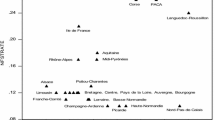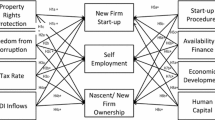Abstract
This paper studies the relationship between entrepreneurship and economic growth using new panel data on the number of new firm registrations in 109 countries for the period 2002–2012. We find strong evidence of a pro-cyclical pattern in entrepreneurship. Furthermore we examine heterogeneous relationships between new firm registration and the business cycle and find that higher levels of financial development and a better business environment are associated with a stronger pro-cyclicality of entrepreneurship both across countries and within countries over time, i.e. a sharper contraction of new firm registrations at the outset of a recession, and a faster recovery of new firm registrations after the recession has ended. These findings suggest that fostering an efficient regulatory environment for the financial and private sector is important for encouraging a speedier recovery in the formation of new firms during economic expansions and aiding the efficient wind-down of insolvent firms during economic slowdowns.



Similar content being viewed by others
Notes
Evidence of a relationship between tighter credit during and economic downturns has been found in both high-income and developing countries. For example, Bernanke and Lown (1999) bring evidence of a decrease in bank lending, or a “credit crunch” in the banking sector, during the 1990 recession in the United States. Similarly, evidence has been found in Korea (Borensztein and Lee, 2002) and Eastern Europe (Guillermo and Coricelli, 1993).
The complete database on new firm registration is available at: www.doingbusiness.org/entrepreneurship.
Data collected from economies categorized by the International Monetary Fund and the Financial Stability Forum as offshore financial centers are excluded from the analysis. See http://www.imf.org/external/np/mae/oshore/2000/eng/back.htm#table 1 and http://www.imf.org/external/np/pp/eng/2008/050808.pdf
See Table 1 for the definition and sources for all variables.
We lose several years of data since Doing Business data is not available for early part of our sample.
These results are also robust to using either starting values of our financial development and business environment measures (using 2003 for financial development and 2004 for business environment), or averages taken over the pre-crisis years, i.e. 2003–2007 or 2004–2007.
References
Aghion, P., Blundell, R., Griffith, R., Howitt, P., & Prantl, S. (2009). The effects of entry on incumbent innovation and productivity. The Review of Economics and Statistics, 91(1), 20–32.
Anyadike-Danes, M., Hart, M., & Lenihan, H. (2010). New business formation in a rapidly growing economy: the Irish experience. Small Business Economics, 36, 503–516.
Audretsch, D. (1995). Innovation and Industry Evolution. Cambridge MA: MIT Press.
Audretsch, D. B., & Acs, Z. J. (1994). New firm start-ups technology and macroeconomics fluctuations. Small Business Economics, 6, 439–449.
Baptista, R., & Preto, M. T. (2007). The dynamics of causality between entrepreneurship and unemployment. International Journal of Technology, Policy and Management, 7(3), 215–224.
Bernanke, B., & Gertler, M. (1989). Agency costs, net worth, and business fluctuations. American Economic Review, 79(1), 14–31.
Bernanke, B., & Lown, C. (1999). The Credit Crunch. Brookings Papers on Economic Activity, 1991(2), 205–247.
Borensztein, E., & Lee, J. W. (2002). Financial Crisis and Credit Crunch in Korea: Evidence from Firm-Level Data. Journal of Monetary Economics, 4(May), 853–875.
Carrasco, R. (1999). Transitions to and from self-employment in Spain: an empirical analysis”. Oxford Bulletin of Economics and Statistics, 61, 315–341.
Carree, M., & Thurik, A. R. (2008). The lag structure of the impact of business ownership on economic performance in OECD countries. Small Business Economics, 30, 101–110.
Ciccone, A., & Papaioannou, E. (2007). Red tape and delayed entry. Journal of the European Economic Association, 5(2), 444–458.
Congregado, E., Golpe, A., & Parker, S. (2012). The dynamics of entrepreneurship hysterisis, business cycles and government policy. Journal of Empirical Economics, 43(3), 1,239–1,261.
Djankov, S., Qian, Y., Roland, G., & Zhuravskaya, E. (2006a). Entrepreneurship in Brazil, China, and Russia. Working Paper No: Centre for Economic and Financial Research at New Economic School. 66.
Evans, D., & Leighton, L. (1990). Small business formation by unemployed and employed workers. Small Business Economics, 2, 319–330.
Fairlie, R. (2011). Entrepreneurship, economic conditions, and the great recession, Institute for the Study of Labor, Discussion paper # 5725.
Fritsch, M., & Mueller, P. (2008). The effect of new business formation on regional development over time: the case of Germany. Small Business Economics, 30, 15–29.
Glaeser, E. (2007). Entrepreneurship and the city, NBER Working Paper # 13551.
Grant, D. (1996). The political economy of new business formation across the American states 1970–1985. Social Science Quarterly, 77, 28–42.
Haltiwanger, J. C., Jarmin, R. S., & Miranda, J. (2010). Who creates jobs? NBER, Working Paper: Small vs. Large Vs. Young. 16300.
Klapper, L., Laeven, L., & Rajan, R. (2006). Entry regulation as a barrier to entrepreneurship.Journal of. Financial Economics, 82(3), 591–629.
Klapper, L., & Love, I. (2011a). Policy Research Working Paper 5493. World: Bank, Washington, DC. “The Impact of Business Environment Reforms on New Firm Registration”.
Klapper, L., & Love, I. (2011b). The Impact of the Financial Crisis on New Firm Registration. Economics Letters, 113(1), 1–4.
Koellinger, P., & Thurik, R. (2012). Entrepreneurship and the Business Cycle. The Review of Economics and Statistics, 94(4), 1143–1156.
Parker, S. C. (2009). The economics of entrepreneurship. Cambridge: Cambridge University Press.
Plummer, L., & Acs, Z. (2005). Penetrating the knowledge filter in regional economies. The Annals of Regional Science, 39(3), 439–456.
Rampini, A. (2004). Entrepreneur activity, risk and the business cycle. Journal of Monetary Economics, 5, 555–573.
Rajan, R., & Zingales, L. (1998). Financial dependence and growth. American Economic Review, 88, 559–586.
Schumpeter, J. (1912). The Theory of Economic Development. Cambridge, MA: Harvard University Press.
Thurik, R., & Wennekers, S. (2004). Entrepreneurship, small business and economic growth. Journal of Small Business and Enterprise Development, 11(1), 140–149.
Thurik, A., Carree, M., van Stel, A., & Audretsch, D. (2008). Does self-employment reduce unemployment? Journal of Business Venturing, 23, 673–686.
Van Stel, A., Carree, M., & Thurik, R. (2005). The effect of entrepreneurial activity on national economic growth. Small Business Economics, 24(3), 311–321.
Van Stel, A., & Storey, D. (2004). The link between firm births and employment: is there an upas tree effect? Regional Studies, 38(8), 893–909.
Wennekers, S., & Thurik, R. (1999). Linking entrepreneurship and economic growth. Small Business Economics, 13, 27–56.
World Bank. (2012). World Development Indicators, 2010. The World Bank: Washington, DC.
World Bank. (2010). Doing Business 2011: Making a Difference for Entrepreneurs. DC: Washington.
Zoromé, A. (2007). Concept of offshore financial centers. In search of an operational definition.
Acknowledgment
We thank the Ewing Marion Kauffman Foundation and the World Bank Group for financial support. This paper's findings, interpretations, and conclusions are entirely those of the authors and do not necessarily represent the views of the World Bank, their Executive Directors, or the countries they represent.
Author information
Authors and Affiliations
Corresponding author
Rights and permissions
About this article
Cite this article
Klapper, L., Love, I. & Randall, D. New firm registration and the business cycle. Int Entrep Manag J 11, 287–306 (2015). https://doi.org/10.1007/s11365-014-0345-0
Published:
Issue Date:
DOI: https://doi.org/10.1007/s11365-014-0345-0




